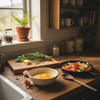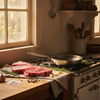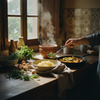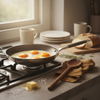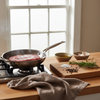What Is A Spatula Used For? Your Complete Guide
Key Takeaways
- A spatula is an essential kitchen tool that helps prevent common cooking mishaps.
- Using the right spatula can make tasks like flipping pancakes or lifting delicate foods easier and more successful.
- Choosing a sturdy and appropriate spatula can improve your confidence and skills in the kitchen.
Table of Contents
- The Spatula Defined, From Ancient Tool to Modern Marvel
- Core Types of Spatulas and Their Signature Roles
- Spatula Materials and Why They Matter for Your Health
- Regional Language and Kitchen Culture Around 'Spatula'
- How to Choose the Perfect Spatula for Your Signature Dish
- Mastering Spatula Techniques, From Weeknight Flips to Pro-Grade Precision
- How to Choose the Perfect Spatula for Your Signature Dishes
- Common Spatula Problems (And How to Solve Them Like a Pro)
What Is A Spatula Used For? Your Complete Guide
Picture this: you're flipping pancakes for Sunday brunch when your plastic spatula melts into the batter. Or worse, you're carefully lifting a delicate fish fillet only to watch it crumble because your flimsy turner bent under pressure. The right spatula transforms these kitchen disasters into culinary triumphs, turning "kitchen novice" into "confident home chef." A seamless spatula set can make all the difference in these scenarios.
A spatula isn't just another utensil cluttering your drawer, it's the versatile workhorse that flips, scrapes, spreads, and serves with precision. For home chefs who refuse to settle for mediocre tools, understanding what is a spatula used for unlocks a world of culinary possibilities, from perfect pancake flips to professional-grade cake decorating. If you want to cover all your bases, consider the 5-piece seamless Di Oro spatula set for every kitchen task.
To dive deeper into the history and versatility of this essential tool, check out this comprehensive guide on what is spatula and discover even more ways to elevate your cooking.
The Spatula Defined, From Ancient Tool to Modern Marvel
At its core, a spatula is a broad, flat implement designed to manipulate food with precision and control. The name derives from the Latin "spatha," meaning sword, fitting for a tool that slices through kitchen challenges with surgical accuracy. Today's spatulas excel at five primary functions: flipping delicate items without breaking, scraping every last bit from mixing bowls, spreading batters and frostings evenly, lifting baked goods intact, and stirring without damaging cookware surfaces.
Early spatulas were carved from wood or bone, evolving through metal iterations before reaching today's science-grade silicone innovations. Modern spatulas like DI ORO's seamless series combine platinum-cured silicone heads with stainless steel cores, creating tools that withstand extreme heat (up to 600°F) while remaining completely free of forever chemicals like PFAS and PFOA.
The anatomy matters: the head provides the working surface, the neck offers flexibility for conforming to curves, and the handle delivers leverage and control. Premium spatulas feature seamless, one-piece construction that eliminates bacteria-harboring crevices, a crucial advancement for both performance and food safety.
Core Types of Spatulas and Their Signature Roles

Understanding what is a spatula used for requires recognizing that different spatula designs excel at specific tasks. Each type features distinct blade shapes, flexibility levels, and construction materials optimized for particular culinary challenges.
| Type | Blade Shape | Core Uses | Performance Notes |
|---|---|---|---|
| Turner/Flipper | Broad, thin, often slotted | Pancakes, burgers, fish | Rigid enough to support weight |
| Scraper/Spoonula | Curved, flexible edges | Bowl scraping, folding batters | Conforms to container curves |
| Offset Spreader | Angled blade, narrow profile | Cake frosting, smoothing | Knuckle clearance for precision |
Flipping and Turning Spatulas, The Heavy Lifters
Turner spatulas feature long handles and broad, relatively rigid blades designed to slide under food and support substantial weight during flipping. The best turners balance flexibility for gentle food release with enough structure to handle thick burger patties or whole fish fillets without bending.
Pro technique: Always preheat your spatula head alongside the pan to minimize sticking, and approach delicate items like fish at a 15-20° angle, using the spatula's flexibility to cradle rather than pierce the protein. For those who love making omelettes or pancakes, a dedicated omelette spatula or a specialized pancake spatula can help you achieve flawless results every time.
Scraping Spatulas, The Bowl Whisperers
Scraping spatulas excel at conforming to curved surfaces, making them indispensable for emptying mixing bowls, folding delicate batters, and incorporating ingredients without overworking. The flexible silicone head bends to match container curves while a reinforced core prevents collapse under thick mixtures.
Master the two-pass technique: hold the spatula at a 45° angle while rotating the bowl, ensuring complete coverage. Spoonula designs bridge the gap between flat scrapers and spoons, allowing seamless transitions from mixing to serving without changing tools. For more on the versatility of silicone spatulas, read this blog post on silicone spatulas for blending and jars.
Spreading Spatulas, The Precision Artists
Offset spatulas feature angled blades that provide knuckle clearance when working on flat surfaces, making them essential for cake decorating and cookie lifting. The angle allows for smooth, controlled spreading motions without your hand interfering with the work surface.
For professional results, maintain a 10-15° blade angle and move in smooth, confident arcs. The offset design also excels at lifting delicate cookies from baking sheets, slide gently underneath with a quick, decisive motion to preserve shape and prevent cracking.
Spatula Materials and Why They Matter for Your Health
The material composition of your spatula directly impacts both cooking performance and food safety. Modern spatulas span four primary materials, each with distinct heat thresholds, maintenance requirements, and health considerations that determine their suitability for different cooking methods.
| Material | Heat Resistance | Maintenance | Best For | Health Considerations |
|---|---|---|---|---|
| Pro-Grade Silicone | Up to 600°F | Dishwasher safe | All cooking methods | Forever-chemical free, LFGB certified |
| Stainless Steel | 1000°F+ | Easy cleaning | Metal cookware only | Inert, no chemical concerns |
| Wood | 200°F maximum | Hand wash only | Gentle stirring | Natural antimicrobial properties |
| Plastic | 150-250°F | Dishwasher safe | Cold preparations | May contain BPA or phthalates |
Silicone, The Forever-Chemical-Free Gold Standard
Premium silicone spatulas represent the pinnacle of modern kitchen tool engineering. Pro-grade, platinum-cured silicone withstands temperatures up to 600°F while remaining completely safe for nonstick surfaces. Unlike cheaper alternatives, quality silicone contains zero PFAS, PFOA, or BPA, the forever chemicals that can leach into food during cooking.
LFGB certification exceeds FDA standards for food contact materials, ensuring that what touches your food meets the highest global safety benchmarks. DI ORO's seamless construction eliminates the joints and crevices where bacteria typically hide, making these spatulas both safer and easier to sanitize than multi-piece alternatives. For those seeking a truly large, professional-grade option, the Seamless Pro 14-Inch Large Silicone Spatula is a top choice for demanding tasks.
Metal, Wood, and Plastic, Understanding the Alternatives
Stainless steel spatulas excel at precision turning tasks and can handle extreme temperatures, but their rigid construction scratches nonstick coatings and can damage delicate foods. Wood offers gentle food handling and natural antimicrobial properties, yet requires hand washing and fails at temperatures above 200°F.
Plastic spatulas provide budget-friendly options for cold preparations but pose significant limitations: most melt below 250°F, potentially releasing harmful chemicals when overheated. Never use plastic spatulas for stovetop cooking or prolonged exposure to hot surfaces.
Regional Language and Kitchen Culture Around 'Spatula'
Understanding what is a spatula used for becomes more complex when regional terminology enters the equation. Culinary traditions across different countries have developed distinct names for similar tools, often reflecting local cooking methods and cultural preferences.
In the United States, "spatula" broadly covers most flat kitchen implements, while British cooks distinguish between "fish slices" (for turning), "palette knives" (for spreading), and "scrapers" (for bowls). Australian kitchens commonly use "egg flip" for turning spatulas, and professional culinary schools worldwide maintain precise terminology that separates tools by specific function rather than general appearance. For a fascinating look at the history of this tool, visit this Smithsonian article on the history of the kitchen spatula.
Why do spatulas have different names? Regional cooking traditions developed independently, creating distinct terminology for similar tools. Professional kitchens standardize names by function (turner, scraper, spreader) rather than using catch-all terms like "spatula."
How to Choose the Perfect Spatula for Your Signature Dish

Selecting the right spatula requires matching tool characteristics to your specific cooking style and signature dishes. Consider four critical factors: the primary foods you prepare, your cookware type, typical cooking temperatures, and the volume of food you regularly handle.
For baking enthusiasts, prioritize flexible scrapers that conform to mixing bowl curves and offset spreaders for cake decorating. Grill masters need rigid turners with broad heads that support heavy proteins without bending. Nonstick cookware users must choose silicone or wood to preserve coating integrity, while cast iron aficionados can utilize any material.
Match spatula head width to your most-used pan size, the spatula should span at least 75% of the pan's diameter for efficient flipping. For delicate work like crepe-making or cookie lifting, choose heads between 2.5-3 inches wide that provide precision control without overwhelming small foods.
Always prioritize seamless, one-piece construction over multi-part designs. Joints and crevices harbor bacteria and food particles that compromise both hygiene and performance, making seamless tools like DI ORO's award-winning series essential for serious home chefs. To see which spatulas are most celebrated, explore these award winning kitchen utensils.
Mastering Spatula Techniques, From Weeknight Flips to Pro-Grade Precision
Professional spatula technique transforms ordinary cooking into precision culinary art. For perfect flipping, timing trumps force, wait until food naturally releases from the cooking surface before attempting to turn. Slide the spatula completely under the food at a shallow angle, lift decisively, and flip with a confident wrist motion rather than tentative prodding.
For spreading tasks, hold your spatula at a 10-15° angle and use smooth, sweeping motions. When frosting cakes, work from the center outward, maintaining consistent pressure. The offset design keeps your knuckles clear while providing maximum control over your spreading medium.
How to Choose the Perfect Spatula for Your Signature Dishes
Matching your spatula to your cooking style transforms kitchen frustration into culinary confidence. Consider your primary cooking methods, preferred cookware, and the dishes you make most frequently.
For baking enthusiasts, prioritize flexible scrapers with seamless construction, they'll clean every trace of batter from mixing bowls and fold ingredients without deflating delicate preparations. Grill masters need wide, slotted turners that slide easily under proteins while draining excess fats. If you want to see top picks for baking, check out this guide to top rated seamless spatulas for baking.
Match spatula head width to your cookware: use tools covering at least 75% of your pan's width for efficient flipping. A 2.5-3 inch head works perfectly for standard cake pans and saucepans, while larger 4-inch heads excel in family-sized skillets.
Pro Selection Tip: Always choose seamless or one-piece construction over multi-part tools. Seams and joints create bacterial hiding spots that compromise food safety, no matter how thoroughly you clean.
Temperature requirements matter significantly. If you regularly sear proteins or work with caramel, invest in spatulas rated above 500°F. DI ORO's 600°F rating handles even the most demanding stovetop tasks without degradation.
Common Spatula Problems (And How to Solve Them Like a Pro)

Melted spatula heads signal inadequate heat resistance for your cooking style. Verify your tool's temperature rating before stovetop use, anything below 400°F will fail during high-heat searing or candy making.
Food sticking to your spatula usually indicates insufficient preheating. Warm the spatula head alongside your pan, creating a thermal barrier that prevents adhesion. For particularly sticky foods, a light oil coating on the spatula surface provides additional release.
Scratched nonstick pans result from using metal tools on delicate surfaces. Switch to silicone for all nonstick cookware, reserving metal spatulas for stainless steel, cast iron, or carbon steel pans that can handle the contact. For more on the science and safety of spatulas, see the Wikipedia entry on spatulas.
Bent or broken spatulas typically stem from inadequate core construction. Multi-piece tools with plastic cores fail under pressure from thick batters or heavy foods. Invest in spatulas with stainless steel cores that maintain rigidity while providing necessary flexibility at the head.
Frequently Asked Questions
What are the main functions of different types of spatulas in cooking?
Different spatulas serve distinct roles: turners flip delicate foods like pancakes or fish, scrapers help you get every last bit from bowls, spreaders smooth batters and frostings, and lifters handle baked goods without breaking. Each type is designed to make specific kitchen tasks easier and more precise.
How do the materials and construction of a spatula impact its performance and safety?
Materials like pro-grade silicone offer heat resistance up to 600°F and are free of forever chemicals, ensuring safety and durability. A sturdy construction, such as a stainless steel core with a seamless silicone head, prevents bending and bacterial buildup, making the spatula both reliable and hygienic for everyday cooking.
What should I consider when choosing the perfect spatula for specific kitchen tasks?
Consider the task at hand, flipping, scraping, spreading, or lifting, and choose a spatula designed for that purpose. Look for heat resistance, durability, and materials that won’t scratch your cookware or leach chemicals into your food. A versatile, well-made spatula set can cover all your kitchen needs with confidence.
How can using the right spatula improve my cooking skills and prevent common kitchen mishaps?
The right spatula gives you control and confidence, helping you flip pancakes without mess, lift delicate fish without crumbling, and scrape bowls clean without waste. Using a tool built for the job reduces frustration, prevents damage to food and cookware, and turns cooking challenges into enjoyable successes.
